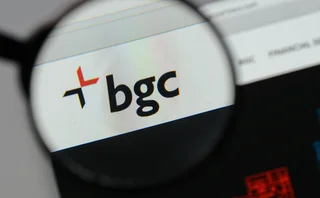
The covered interest parity conundrum
Darrell Duffie explains why it’s difficult to arbitrage direct and swap-implied funding rates
Darrell Duffie is the Dean Witter distinguished professor of finance at Stanford University’s Graduate School of Business, and professor by courtesy in the university’s economics department. He has recently been an adviser on financial markets to a range of bodies, including the Financial Stability Board and several Federal Reserve banks.
It has become significantly cheaper for some big banks to borrow US dollars outright in wholesale funding markets than to borrow dollars indirectly through other currencies. The indirect method is to borrow euros, for example, and to exchange the euros for dollars (at spot, and back again at maturity) using foreign exchange swaps or currency swaps. The two US dollar interest rates, direct and swap-implied, should be the same, absent arbitrage, a fact known as covered interest parity (CIP). The difference in these two rates is called the CIP basis.
Between 2010 and 2016, on average over major currencies, Du, Tepper, and Verdelhan (2017) estimate a CIP basis of –24 basis points at three months and –27bp at five years. In some currencies, especially the yen, they show that the basis has been much wider.
Du, Tepper, Verdelhan and researchers at the Bank for International Settlements have also explained how the CIP basis responds to currency carry trades and to dollar funding pressures in Europe and Japan. But why haven’t big banks simply driven the basis back to its tiny pre-crisis levels? For example, when the euro CIP basis is significantly negative, it is an arbitrage to borrow dollars, buy euros with the proceeds, invest the euros to maturity, and pre-sell the maturing euros for dollars in the forward market.
While the profit to some big banks for arbitraging the basis is real, this does not imply that their shareholders always benefit from the trade. A CIP basis trade may require an expansion of a bank’s balance sheet, which, in turn, implies an increase in the amount of capital required by regulation. Adding capital can benefit a bank’s creditors at the expense of its shareholders.
Suppose, for illustration, that every $100 increase in some bank’s assets requires an additional $6 of capital. The capital raised can be used to retire $6 of debt. The present value V of the benefit of the capital raise for the remaining creditors can be estimated as the expected recovery that would have been paid to $6 of debt claims if the bank defaults.
While the profit to some big banks for arbitraging the basis is real, this does not imply that their shareholders always benefit from the trade
Darrell Duffie
To simplify the calculation of V, I will take the arbitrage period to be one year and the risk-free rate to be zero.
The present value of the default recovery to each dollar of debt claim is the risk-neutral default probability p multiplied by the default recovery rate R. We can estimate that p = S/(1–R), where S is the bank’s credit spread. We thus have V = 6SR/(1–R). Taking R = 0.5, for example, V = 6S. At a credit spread of, say, 200bp, the value to creditors of the capital raise is about $0.12 per $100 of balance sheet increase, or 12bp.
That is, by making the balance sheet safer through increased capital, with essentially no increase in risk, the trade has shifted some of the value of the bank’s assets away from its equity owners to its creditors. The equity owners have given up 12bp to creditors, so the bank should only be willing to do the trade if the magnitude of the CIP basis is at least 12bp, net of transactions costs.
Banks face various capital, liquidity, and other regulations. Which of these are binding is not obvious. This example merely illustrates that even a true arbitrage is not necessarily attractive to bank shareholders.
That regulatory capital constraints play a big role in the CIP basis is buttressed by the fact that the magnitude of the basis in some currencies, especially yen, increases sharply at quarter-ends, when non-US banks are checked for capital adequacy.
Rime, Schrimpf, and Syrstad (2016) show that short-maturity CIP arbitrage does not even exist at the pricing terms available to many of the largest non-US banks, which tend to have credit ratings placing them in a lower tier. These banks borrow incremental dollars at higher rates than suggested by market benchmarks such as Libor.
A commonly stated rule of thumb is that a balance-sheet-expanding trade is justified if it generates a profit in excess of the bank’s return on equity (ROE) multiplied by the amount of capital required for the trade.
This is not correct. If it were, then a riskless arbitrage would have the same required profit per unit of capital as a risky real estate loan. That makes no sense.
Perhaps the CIP basis would be narrower if more banks were to abandon the incorrect ROE test. The acid test is whether a trade increases the market value of the bank’s equity, after capturing the impact of any required balance-sheet changes.
Only users who have a paid subscription or are part of a corporate subscription are able to print or copy content.
To access these options, along with all other subscription benefits, please contact info@risk.net or view our subscription options here: http://subscriptions.risk.net/subscribe
You are currently unable to print this content. Please contact info@risk.net to find out more.
You are currently unable to copy this content. Please contact info@risk.net to find out more.
Copyright Infopro Digital Limited. All rights reserved.
You may share this content using our article tools. Printing this content is for the sole use of the Authorised User (named subscriber), as outlined in our terms and conditions - https://www.infopro-insight.com/terms-conditions/insight-subscriptions/
If you would like to purchase additional rights please email info@risk.net
Copyright Infopro Digital Limited. All rights reserved.
You may share this content using our article tools. Copying this content is for the sole use of the Authorised User (named subscriber), as outlined in our terms and conditions - https://www.infopro-insight.com/terms-conditions/insight-subscriptions/
If you would like to purchase additional rights please email info@risk.net
More on Markets
Softer FX rules for China QFIs set to boost CNY competition
Freedom to circumvent local custodians a plus for pricing and best execution – State Street
Allianz Life drops single-name CDS positions in Q4
Counterparty Radar: US life insurance industry volumes sink to lowest level in two years
Sustainable bond markets miss an options trick
A derivatives mindset could boost lagging sustainability-linked market, argues climate think-tank
FX dealers face end-of-day trading stress from T+1 shift
Experts say switch to using overnight swaps could be “problematic” and lead to wider spreads
Consortium backs BGC’s effort to challenge CME
Banks and market-makers – including BofA, Citi, Goldman, Jump and Tower – will have a 26% stake in FMX
Natixis turns on the taps in flow trading
French bank boosts flow business, balancing structured solutions capabilities
Rethinking P&L attribution for options
A buy-side perspective on how to decompose the P&L of index options is presented
Buy side would welcome more guidance on managing margin calls
FSB report calls for regulators to review existing standards for non-bank liquidity management
Most read
- Industry urges focus on initial margin instead of intraday VM
- For a growing number of banks, synthetics are the real deal
- Revealed: the three EU banks applying for IMA approval








